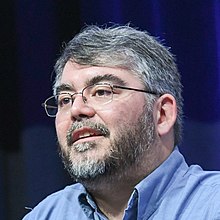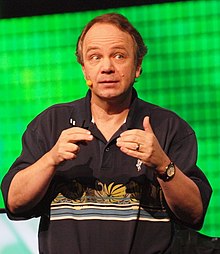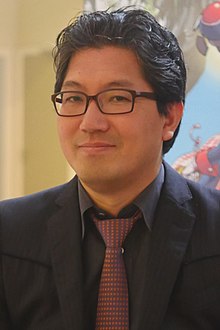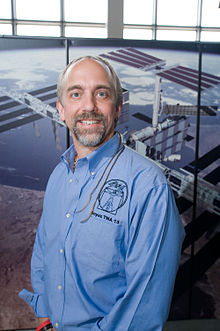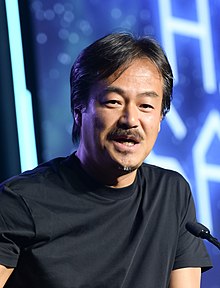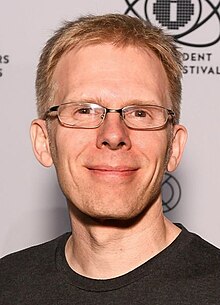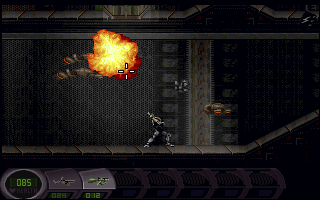Portal:Video games
Portal maintenance status: (April 2019)
|
The Video Games Portal

A video game, sometimes further qualified as a computer game, is an electronic game that involves interaction with a user interface or input device (such as a joystick, controller, keyboard, or motion sensing device) to generate visual feedback from a display device, most commonly shown in a video format on a television set, computer monitor, flat-panel display or touchscreen on handheld devices, or a virtual reality headset. Most modern video games are audiovisual, with audio complement delivered through speakers or headphones, and sometimes also with other types of sensory feedback (e.g., haptic technology that provides tactile sensations). Some video games also allow microphone and webcam inputs for in-game chatting and livestreaming.
Video games are typically categorized according to their hardware platform, which traditionally includes arcade video games, console games, and computer games (which includes LAN games, online games, and browser games). More recently, the video game industry has expanded onto mobile gaming through mobile devices (such as smartphones and tablet computers), virtual and augmented reality systems, and remote cloud gaming. Video games are also classified into a wide range of genres based on their style of gameplay and target audience. (Full article...)
Featured articles – load new batch
-
Image 1BioShock 2 is a first-person shooter video game developed by 2K Marin and published by 2K Games. It was released worldwide for PlayStation 3, Windows, and Xbox 360 on February 9, 2010; Feral Interactive released an OS X version on March 30, 2012. The game takes place in the dystopian underwater city of Rapture, eight years after the events of BioShock. In the single-player campaign, players control the armored protagonist Subject Delta as he fights through Splicers—the psychotic human population of the city—using weapons and an array of genetic modifications. The game includes a story-driven multiplayer mode that takes place before the events of BioShock, during Rapture's civil war.
After the success of BioShock, 2K Games formed a new studio, 2K Marin, to create the sequel. 2K Australia, Arkane Studios, and Digital Extremes provided additional support. The developers focused on improving gameplay elements from the first game, and return to the Rapture setting to explore a new perspective of the city. The story received major changes throughout development. Garry Schyman, who composed BioShock's soundtrack, returned for the sequel; he expanded the game's sonic palette to include more blues and religious music to parallel its themes.
BioShock 2 received positive reviews, with praise directed at its narrative, themes, art style, characters, endings and gameplay. Criticisms included a slow start and failure to distinguish itself from its predecessor. Retrospective reviews have been more positive, with some considering it the best in the series. The multiplayer mode was supported with downloadable content, and a single-player campaign expansion, Minerva's Den, released in August 2010. The game sold more than 3 million copies, but did not meet the publisher's sales expectations. A remastered version titled BioShock 2 Remastered was released as part of BioShock: The Collection for PlayStation 4, Windows, Xbox One, and Nintendo Switch. (Full article...) -
Image 2Mischief Makers is a side-scrolling platform game developed for the Nintendo 64 gaming console by Treasure, and published in 1997 by Enix in Japan and by Nintendo internationally. The player assumes the role of Marina Liteyears, a robotic maid who journeys to rescue her creator, Professor Theo, from the emperor of Planet Clancer. The gameplay is displayed in 2.5D, based on grabbing, shaking, and throwing objects within five worlds and 52 levels.
It is the first 2D side-scrolling game for the Nintendo 64, and Treasure's first release for a Nintendo console. The 12-person team began development in mid-1995 with little knowledge of the prototype console. The team wanted to make a novel gameplay mechanic, and implementing the resultant "catching" technique became their most difficult task. The game was announced at the 1997 Electronic Entertainment Expo and was released in Japan on June 27 that year and later in the United States, Europe, and Australia.
Mischief Makers received mixed reviews. Critics praised its inventiveness, personality, and boss fights, but criticized its short length, low difficulty, low replay value, sound, and harsh introductory learning curve. Retrospective reviewers disagreed with the originally poor reception, and multiple reviewers noted Marina's signature "Shake, shake!" sound bite as a highlight. Video game journalists appealed for its reissue either through the Nintendo eShop or in a sequel or franchise reboot. In 2009, GamesRadar called it possibly the most underrated Nintendo 64 game. (Full article...) -
Image 3

Accolade, Inc. (later Infogrames North America, Inc.) was an American video game developer and publisher based in San Jose, California. The company was founded as Accolade in 1984 by Alan Miller and Bob Whitehead, who had previously co-founded Activision in 1979. The company became known for numerous sports game series, including HardBall!, Jack Nicklaus and Test Drive.
By the early 1990s, Accolade saw critical acclaim for Star Control (1990), as well as strong sales for Bubsy (1993). However, Sega sued Accolade for creating unauthorized Sega Genesis games by reverse-engineering the console's boot-protection. Accolade won the case on appeal, overturning an injunction from the lower court that had interrupted their sales and development. The founders soon left the company. The new chief executive, Peter Harris, attracted new investment from Time Warner. The following year, Accolade president Jim Barrett replaced him. He focused on existing franchises hoping to secure the company's future. However, technical issues undermined the release of Bubsy 3D (1996), and Jack Nicklaus 5 (1997) was considered a commercial disappointment, despite positive reviews. The company still had modest successes with games such as Star Control 3 (1996) and Deadlock (1996), and saw strong sales for both Test Drive 4 (1997) and Test Drive: Off Road (1997).
The French firm Infogrames purchased Accolade in 1999 as part of its strategy to become more global, transforming it into a subsidiary called Infogrames North America. By 2000, it was consolidated into Infogrames, Inc. (the former GT Interactive), marking the end of Infogrames North America as a separate company and what remained of Accolade as an entity. In the years that followed, Infogrames purchased the Atari trademark and rebranded as Atari SA, before declaring bankruptcy in 2013 resulting in the sell-off of some assets. The Accolade assets were purchased by game publisher Tommo, who later resold them to Hong Kong–based holding company Billionsoft as part of a strategy to revive several classic games, however the assets that Billionsoft held were re-acquired by Atari SA in April 2023. (Full article...) -
Image 4Star Control 3 is a 1996 action-adventure game developed by Legend Entertainment and published by Accolade. The third installment in the Star Control trilogy, the game was released for MS-DOS in 1996 and Mac OS in 1998. The story takes place after Star Control II, beginning with a disaster that disrupts superluminal travel through hyperspace. This leads the player to investigate a new quadrant of space, joined by allied aliens from the previous games.
The game features a single-player campaign that is similar to the previous installment, combining space exploration, alien dialogue, and ship-to-ship combat. As a mainstay of the series, the player engages in top-down battles between starships with unique abilities. In contrast to Star Control II, hyperspace flight is replaced with instantaneous fast travel. Planetary exploration is replaced with a colony management system, inspired by the original Star Control. Combat offers more detailed steering and aiming, as well as additional player-versus-player multiplayer options.
Accolade hired Legend Entertainment to create this sequel after the series creators Paul Reiche III and Fred Ford decided to pursue other projects. Legend was selected due to their passion for the previous Star Control games, as well as their experience as veteran game writers from the acclaimed adventure game studio Infocom. They designed the game in consultation with fans, replacing features from Star Control II that received negative feedback. Star Control 3 was considered a critical and commercial success upon release, with praise for its story and varied gameplay. However, the game later suffered from comparisons to the award-winning Star Control II, with a mixed legacy among both fans and critics. (Full article...) -
Image 5Cloud is a 2005 puzzle video game developed by a team of students in the University of Southern California's (USC) Interactive Media Program. The team began development of the game for Microsoft Windows in January 2005 with a US$20,000 grant from the USC Game Innovation Lab; the game was released as a free download that October. By July 2006, the hosting website had received 6 million visits, and the game had been downloaded 600,000 times.
The game centers on a boy who dreams of flying while asleep in a hospital bed. The concept was partially based on lead designer Jenova Chen's childhood; he was often hospitalized for asthma and would daydream while alone in his room. Assuming the role of the boy, the player flies through a dream world and manipulates clouds to solve puzzles. The game was intended to spark emotions in the player that the video game industry usually ignored.
Cloud won the Best Student Philosophy award at the 2006 Slamdance Guerrilla Games Competition, and a Student Showcase award at the 2006 Independent Games Festival. The game was received well by critics, who cited its visuals, music, and relaxing atmosphere as high points. Chen and producer Kellee Santiago went on to co-found the studio Thatgamecompany, which has considered remaking Cloud as a commercial video game. (Full article...) -
Image 6The Halo Graphic Novel is a graphic novel anthology of the military science fiction video game series Halo, published by Marvel Comics in partnership with Bungie. The Halo Graphic Novel was the series' first entry into the sequential art medium, and features aspects of the Halo universe which until then had not been discussed or seen in any medium.
The majority of the book is divided into four short stories by different writers and artists from the computer game and comic industries. Each story focuses on different aspects of the Halo universe, revealing stories that are tangential to the main plot of the game. Apart from the stories, the book also contains an extensive art gallery compiled of contributions from Bungie, Marvel and independent sources.
Released on July 19, 2006, The Halo Graphic Novel was well-received, with reviewers noting the cohesiveness of the work as a whole, as well as the diversity of the individual material. The success of the novel led to Marvel announcing a new limited comic series, Halo: Uprising, and other future Halo comic books. (Full article...) -
Image 7Master Chief Petty Officer John-117, colloquially known as Master Chief, is the protagonist of the Halo video game series and its spin-off media. The character first appeared in the 2001 video game Halo: Combat Evolved, a science fiction first-person shooter that became a long-running franchise. The character also appears in spin-off Halo media such as the 2012 film Halo 4: Forward Unto Dawn, the 2022 Halo television series, and several graphic novels and books.
The Master Chief is a towering supersoldier known as a "Spartan", trained from childhood for combat. The designers intended for players to be able to project their own intentions into the character and thus reduced his voiced lines and concealed his appearance under his armor. In the video games, the character is voiced by former disc jockey Steve Downes, who based his performance on Bungie's description calling for a man of few words, similar to Clint Eastwood. In spin-off media, he is portrayed by different voice and physical actors, most notably Pablo Schreiber on the 2022 live-action TV series.
A pop culture icon, Master Chief is widely regarded as one of the greatest video game characters of all time, with the character being seen as a mascot for Halo and the Xbox brand. His 2001 debut received a generally positive reception for his character design, with publications praising how the narrative allows players to inhabit the character, while others have criticized him as under characterized. In later Halo games developed by 343 Industries, the characterization of Master Chief earned praise for exploring his humanity and his relationship with Cortana. (Full article...) -
Image 8Trials of Mana, also known by its Japanese title Seiken Densetsu 3, is a 1995 action role-playing game developed and published by Square (now Square Enix) for the Super Famicom. It is the sequel to the 1993 game Secret of Mana, and is the third installment in the Mana series. Set in a high fantasy world, the game follows three heroes as they attempt to claim the legendary Mana Sword and prevent the Benevodons from being unleashed and destroying the world. It features three main plotlines and six different possible main characters, each with their own storylines, and allows two players to play simultaneously. Trials of Mana builds on the gameplay of its predecessor with multiple enhancements, including the use of a time progression system with transitions from day to night and weekday to weekday in game time, and a wide range of character classes to choose from, which provides each character with an exclusive set of skills and status progression.
The game was designed by series creator Koichi Ishii, directed by veteran Square designer Hiromichi Tanaka, and produced by Tetsuhisa Tsuruzono. Artwork was produced by manga and anime artist Nobuteru Yūki, while the music was composed by Secret of Mana composer Hiroki Kikuta. Although the game was only published in Japan, English-speaking players had been able to play Seiken Densetsu 3 due to an unofficial English fan translation released in 1999. Seiken Densetsu 3 received considerable acclaim from reviewers, who praised the graphics as among the best ever made for the Super Famicom and the gameplay as an improved version of its predecessor's. The plot received mixed reviews by critics, who found the overlapping stories to be interesting and to enhance replayability, but the characters and plotlines themselves to be flat and clichéd. Overall, the game is considered by some critics to be a Super Famicom classic.
In June 2017, the game was included in the Seiken Densetsu Collection release for the Nintendo Switch in Japan; the collection was released in June 2019 in North America and the PAL region as Collection of Mana with Seiken Densetsu 3 titled Trials of Mana. A 3D remake of the same name was announced alongside it, and released worldwide in April 2020 for Microsoft Windows, Nintendo Switch and PlayStation 4. The remake was released for Xbox Series X/S in 2024. (Full article...) -
Image 9

Freedom Planet is a 2014 platform video game developed and published by GalaxyTrail. The player controls one of three anthropomorphic animal protagonists: the dragon girl Lilac, the wildcat Carol, or the basset hound Milla. Aided by a duck-like alien named Torque, the girls attempt to defeat the evil Lord Brevon, who plans to steal the Kingdom Stone and conquer the galaxy. While the game focuses on fast-paced platforming, its levels are interspersed with slower action scenes.
Game director Sabrina DiDuro first began developing Freedom Planet as a Sonic the Hedgehog fangame using characters created by DeviantArt user Ziyo Ling for its main cast. Early into development, she lost interest in creating a derivative work and reconceived the project as her own intellectual property. Sash Lilac, originally a hedgehog, became a dragon; antagonist Doctor Eggman was replaced by Lord Brevon with his eyebrows resembling Doctor Eggman's mustache; and the Sonic series' ring-based health system was abandoned. Further changes were suggested by fans and incorporated throughout development. Freedom Planet was developed in Denmark and the United States, with its art direction carrying East Asian influences, such as medieval Chinese art inspiring its background visuals.
With development focused on the Windows platform, the game started out as a demo first released in August 2012 and was, after a successful Kickstarter campaign, released in its entirety via Steam in July 2014. Freedom Planet was later released for the Wii U in October 2015, for the PlayStation 4 in 2017, and for the Nintendo Switch in August 2018. The game received largely positive reviews; critics praised its gameplay, visuals, music, aesthetics, sense of humor and balance of Sonic elements with original content, but were mixed on its pacing, voice acting, story and the abundance of long cutscenes. (Full article...) -
Image 10System Shock is a 1994 first-person action-adventure video game developed by LookingGlass Technologies and published by Origin Systems. It was directed by Doug Church with Warren Spector serving as producer. The game is set aboard a space station in a cyberpunk vision of the year 2072. Assuming the role of a nameless security hacker, the player attempts to hinder the plans of a malevolent artificial intelligence called SHODAN.
System Shock's 3D engine, physics simulation and complex gameplay have been cited as both innovative and influential. The developers sought to build on the emergent gameplay and immersive environments of their previous games, Ultima Underworld: The Stygian Abyss and Ultima Underworld II: Labyrinth of Worlds, by streamlining their mechanics into a more "integrated whole"; it is considered one of the defining examples of an immersive sim.
Critics praised System Shock and hailed it as a major breakthrough in its genre. It was later placed on multiple hall of fame lists. The game was a moderate commercial success, with sales exceeding 170,000 copies, but Looking Glass ultimately lost money on the project. A sequel, System Shock 2, was released by Looking Glass Studios and offshoot developer Irrational Games in 1999. The 2000 game Deus Ex (produced and directed by Spector), the 2007 game BioShock, and the 2017 game Prey are spiritual successors to the two games. A remake by Nightdive Studios was released on 30 May 2023. (Full article...)
Did you know... - show different entries
- ... that the video game Manor Lords was wishlisted more than three million times on Steam after its developer had estimated it would receive around 14,000?
- ... that the urban legend Herobrine was ranked on a Guinness World Records poll of the best video game villains, despite never existing?
- ... that Through the Darkest of Times was the first video game published in Germany to use swastikas?
- ... that the 2014 text adventure The Uncle Who Works for Nintendo is inspired by a source cited by children for spreading video game rumors?
- ... that the 1979 video game Superman was one of the first console games with a pause feature?
- ... that approximately 85 percent of Manhattan was recreated for the 2008 video game The Incredible Hulk?
- ... that the video game JFK Reloaded recreates the assassination of John F. Kennedy from the perspective of the killer?
- ... that MicroProse was formed to publish Hellcat Ace after Sid Meier boasted that he could design a better video game than Red Baron in a week?
- ... that the 1987 video game Oriental Hero was panned as "so incredibly bad it's almost worth a look"?
- ... that the success of Kingdom Rush prompted plans to grow the video game industry of Uruguay?
- ... that the case Lewis Galoob Toys, Inc. v. Nintendo of America, Inc. was considered essential to the future of video game modding in the United States in 1992?
- ... that the Chicago Sun-Times credits JumpStart Toddlers as the first video game targeted towards babies?
Selected biography – load new batch
-
Image 1
Raphael "Raph" Koster (born September 7, 1971) is an American entrepreneur, game designer, and author of A Theory of Fun for Game Design. Koster is widely recognized for his work as the lead designer of Ultima Online and the creative director behind Star Wars Galaxies. From 2006 until 2013 he worked as the founder and president of Metaplace (previously operating as Areae and acquired by social gaming company Playdom in 2010, which was in turn acquired by Disney) producing a Facebook game platform. (Full article...) -
Image 2Hiroshi Yamauchi (山内溥, Yamauchi Hiroshi, 7 November 1927 – 19 September 2013) was a Japanese businessman and the third president of Nintendo, joining the company on 25 April 1949 until stepping down on 24 May 2002, being succeeded by Satoru Iwata. During his 53-year tenure, Yamauchi transformed Nintendo from a hanafuda card-making company that had been active solely in Japan into a multibillion-dollar video game publisher and global conglomerate. He was the great-grandson of Fusajiro Yamauchi, Nintendo's first president and founder. Hiroshi Yamauchi owned the Seattle Mariners baseball team from 1992 until his death.
In April 2013, Forbes estimated Yamauchi's net worth at $2.1 billion; he was the 13th richest person in Japan and the 491st richest in the world. In 2008, Yamauchi was Japan's wealthiest person with a fortune at that time estimated at $7.8 billion. At the time of his death, Yamauchi was the largest shareholder at Nintendo. (Full article...) -
Image 3Daigo Umehara (Japanese: 梅原 大吾, Hepburn: Umehara Daigo, born 19 May 1981) is a Japanese esports player and author who competes competitively at fighting video games. He specializes in 2D arcade fighting games, mainly those released by Capcom. Known as "Daigo" or "The Beast" in the West and "Umehara" (ウメハラ, written in katakana instead of kanji) or "Ume" in Japan, Daigo is one of the world's most famous Street Fighter players and is often considered its greatest. His longevity is seen as an incredibly rare thing in the world of competitive video games. He currently holds a world record of "the most successful player in major tournaments of Street Fighter" in the Guinness World Records and is a six time Evo Championship Series winner.
Before properly being called a pro gamer from signing a sponsorship deal with Mad Catz, Japanese media usually referred to Daigo as "the god of 2D fighting games" (2D格闘ゲームの神, 2D Kakutō Gēmu no Kami). (Full article...) -
Image 4Persson at the 2016 Game Developers Conference
Markus Alexej Persson (/ˈpɪərsən/ ⓘ PEER-sən, Swedish: [ˈmǎrːkɵs ˈpæ̌ːʂɔn] ⓘ; born 1 June 1979), also known as Notch, is a Swedish video game programmer and designer. He is the creator of Minecraft, which is the best-selling video game in history. He founded the video game development company Mojang Studios in 2009.
Persson began developing video games at an early age. His commercial success began after he published an early version of Minecraft in 2009. Prior to the game's official retail release in 2011, it had sold over ten million copies. After this point Persson stood down as the lead designer and transferred his creative authority to Jens Bergensten. In September 2014 Persson announced on his personal website that he had concluded he "[didn't have the connection to his fans he thought he had]", that he had "become a symbol", and that he did not wish to be responsible for Mojang's increasingly large operation. He left Mojang in November of that year, selling his company to Microsoft reportedly for US$2.5 billion. The acquisition made Persson a billionaire. (Full article...) -
Image 5Keiji Inafune (稲船 敬二, Inafune Keiji, born 8 May 1965) is a Japanese video game producer, character designer, game designer, and businessman. In 2009, he was chosen by IGN as one of the top 100 game creators of all time.Inafune at Japan Expo 2012
Starting his career at Capcom in the late 1980s, his job was as an artist and illustrator. The first two games he worked on were the original Street Fighter and Mega Man in 1987. He was then a character designer and planner of the Mega Man series during the NES and Super NES era. For Mega Man X, he created and designed the character Zero. (Full article...) -
Image 6
William Murray "Trip" Hawkins III (born December 28, 1953) is an American entrepreneur and founder of Electronic Arts, The 3DO Company, and Digital Chocolate. (Full article...) -
Image 7
Todd Andrew Howard (born 1970) is an American video game designer, director, and producer. He serves as director and executive producer at Bethesda Game Studios, where he has led the development of the Fallout and The Elder Scrolls series. He was also the game director for Starfield. (Full article...) -
Image 8Yoko Kanno (菅野 よう子, Kanno Yōko, born 18 March 1963) is a Japanese composer, arranger and music producer of soundtracks for anime series, video games, television dramas and movies. She has written scores for Cowboy Bebop, Terror in Resonance, Ghost in the Shell: Stand Alone Complex, Wolf's Rain, Turn A Gundam and Darker than Black. Kanno is a keyboardist and the frontwoman for Seatbelts, who perform many of her compositions. (Full article...)Kanno at Anime Expo 2010
-
Image 9Tomohiro Nishikado (西角 友宏, Nishikado Tomohiro, born March 31, 1944) is a Japanese video game developer and engineer. He is the creator of the arcade shoot 'em up game Space Invaders, released to the public in 1978 by the Taito Corporation of Japan, often credited as the first shoot 'em up and for beginning the golden age of arcade video games. Prior to Space Invaders, he also designed other earlier Taito arcade games, including the shooting electro-mechanical games Sky Fighter (1971) and Sky Fighter II, the sports video game TV Basketball in 1974, the vertical scrolling racing video game Speed Race (also known as Wheels) in 1974, the multi-directional shooter Western Gun (also known as Gun Fight) in 1975, and the first-person combat flight simulator Interceptor (1975). (Full article...)
-
Image 10Meier at the 2010 Game Developers Conference
Sidney K. Meier (/ˈmaɪər/ MIRE; born February 24, 1954) is an American businessman and computer programmer. A programmer, designer, and producer of several strategy video games and simulation video games, including the Civilization series, Meier co-founded MicroProse in 1982 with Bill Stealey and is the Director of Creative Development of Firaxis Games, which he co-founded with Jeff Briggs and Brian Reynolds in 1996. For his contributions to the video game industry, Meier was inducted into the Academy of Interactive Arts and Sciences Hall of Fame. (Full article...) -
Image 11Ken Kutaragi (久夛良木 健, Kutaragi Ken, born 2 August 1950) is a Japanese engineering technologist and businessman, currently president and CEO of Cyber AI Entertainment. Formerly the chairman and CEO of Sony Computer Entertainment (SCE), the video game division of Sony, Kutaragi is known as "The Father of the PlayStation" having overseen the development of the original console and its successors and spinoffs until departing the company in 2007, shortly after the PlayStation 3 was released.Kutaragi with his Lifetime Achievement Award at the Game Developers Choice Awards 2014
Kutaragi had also designed the sound processor for the Super Nintendo Entertainment System. With Sony, he designed the VLSI chip, which works in conjunction with the PS1's RISC CPU to handle the graphics rendering. (Full article...) -
Image 12
Jennifer Hale is a Canadian-American voice actress. She is best known for her work in video game franchises such as Baldur's Gate, Mass Effect, Metal Gear Solid, BioShock Infinite, Metroid Prime, Halo, Overwatch, and Star Wars: Knights of the Old Republic. In 2013, she was recognized by Guinness World Records as the most prolific video game voice actor.
Hale is featured in animation such as The Real Adventures of Jonny Quest, The Powerpuff Girls, Codename: Kids Next Door, The Grim Adventures of Billy & Mandy, Brandy & Mr. Whiskers, Totally Spies!, Avatar: The Last Airbender and its continuation The Legend of Korra, Where on Earth Is Carmen Sandiego? and Star Wars: The Clone Wars. She also voices Thorn of the Hex Girls in various Scooby-Doo movies and TV episodes, as well as Cinderella and Princess Aurora in various Disney Princess media of the 2000s and 2010s. She is also known for voicing Jean Grey in a variety of Marvel media, most recently in X-Men '97. (Full article...) -
Image 13
Anita Sarkeesian (/sɑːrˈkiːziən/ sar-KEE-zee-ən; born 1983) is a Canadian-American feminist media critic. She is the founder of Feminist Frequency, a website that hosts videos and commentary analyzing portrayals of women in popular culture. Her video series Tropes vs. Women in Video Games, examines tropes in the depiction of female video game characters.
Media scholar Soraya Murray calls Sarkeesian emblematic of "a burgeoning organized feminist critique" of stereotyped and objectified portrayals of women in video games.
In 2012, Sarkeesian was targeted by an online harassment campaign following her launch of a Kickstarter project to fund the Tropes vs. Women in Video Games series. The threats and harassment generated widespread media attention, and resulted in the project far exceeding its funding goal. The media coverage placed Sarkeesian at the center of discussions about misogyny in video game culture and online harassment. She has spoken to TEDxWomen, XOXO Festival, and the United Nations' Broadband Working Group on Gender, and appeared on The Colbert Report discussing her experiences of harassment and the challenge of attempting to improve gender inclusivity in gaming culture and the media. (Full article...) -
Image 14
Lim Yo-hwan (Korean: 임요환; Hanja: 林遙煥, born September 4, 1980), known online as SlayerS_'BoxeR' (usually shortened to BoxeR), is a former professional player of the real-time strategy computer game StarCraft. He is often referred to as The Terran Emperor, or simply The Emperor, and is widely considered to be one of the most successful players of the genre as well as a pop culture icon.
Lim won his first StarCraft: Brood War tournament in 1999. From 2001 to 2002, he won multiple major championships, including two OnGameNet Starleague titles and two World Cyber Games gold medals. In 2002, he also created the team Team Orion, which later became SK Telecom T1 (SKT T1) in 2004. He began his compulsory military service in 2006, where he played on South Korea's newly formed Air Force esports team Airforce Challenge E-sports. In late 2010, he retired from StarCraft: Brood War and founded the StarCraft II team SlayerS. He then briefly returned to SKT T1 as a coach in 2012 before retiring due to health related issues. Lim finished his playing career with a record of 603 wins and 430 losses (58.4%). (Full article...) -
Image 15
Mark Edward Fischbach (/ˈfɪʃˌbɑːk/ FISH-bahk; born June 28, 1989), known online as Markiplier, is an American YouTuber, actor, filmmaker, and influencer. One of the most popular YouTubers on the platform, he is known for his "Let's Play" videos of indie horror games. He was listed by Forbes as the third highest-paid content creator on the platform in 2022, and has won four Streamy Awards and a Golden Joystick Award. He has spun off his YouTube fame into a media career, venturing into acting and filmmaking.
After joining YouTube in 2012, Fischbach became popular on the platform with Let's Plays of Amnesia: The Dark Descent (2010) and the Five Nights at Freddy's series; as of 2024, his channel had over 37 million subscribers. He signed with talent agency William Morris Endeavor in 2016. While with the agency, he released a clothing line, wrote and directed the YouTube Original series A Heist with Markiplier (2019) and In Space with Markiplier (2022), and hosted or co-hosted two podcasts which reached No. 1 on Spotify. (Full article...) -
Image 16Gunpei Yokoi (横井 軍平, Yokoi Gunpei, 10 September 1941 – 4 October 1997), sometimes transliterated as Gumpei Yokoi, was a Japanese toy maker and video game designer. As a long-time Nintendo employee, he was best known as creator of the Game & Watch handheld system, inventor of the cross-shaped Control Pad, the original designer of the Game Boy, and producer of a few long-running and critically acclaimed video game franchises such as Metroid and Kid Icarus. (Full article...)
-
Image 17
Jeremy Soule (/soʊl/ SOHL; born December 19, 1975) is an American composer of soundtracks for film, television, and video games. He has composed soundtracks for over 60 games and over a dozen other works during his career, including The Elder Scrolls, Guild Wars, Icewind Dale, and the Harry Potter series.
He became an employee of Square in 1994 after several years of private composition studies. After finishing the soundtrack to Secret of Evermore in 1995, he left to join Humongous Entertainment, where he composed for several children's games as well as Total Annihilation, his first award-winning score. In 2000, he left to form his own music production company, Soule Media, later called Artistry Entertainment. In 2005, he founded DirectSong, a record label that published digital versions of his soundtracks as well as those of classical composers. DirectSong remained active until 2019. (Full article...) -
Image 18Yuji Naka (中 裕司, Naka Yūji, born September 17, 1965), credited in some games as YU2, is a Japanese former video game programmer, designer and producer. He is the co-creator of the Sonic the Hedgehog series and was the president of Sonic Team at Sega until his departure in 2006.
Naka joined Sega in 1984 and worked on games including Girl's Garden (1985) and Phantasy Star II (1989). He was the lead programmer of the original Sonic games on the Mega Drive in the early 1990s, which greatly increased Sega's market share. After developing Sonic the Hedgehog (1991) in Japan, Naka moved to California to develop Sonic the Hedgehog 2 (1992), Sonic the Hedgehog 3 (1994) and Sonic & Knuckles (1994) with Sega Technical Institute. (Full article...) -
Image 19
Richard Allen Garriott (born 4 July 1961) is a British-born American video game developer, entrepreneur and private astronaut.
Garriott, who is the son of NASA astronaut Owen Garriott, was originally a game designer and programmer, and is now involved in a number of aspects of computer-game development. On October 12, 2008, Garriott flew aboard the Soyuz TMA-13 mission to the International Space Station as a private astronaut, returning 12 days later aboard Soyuz TMA-12. He became the second space traveler, and first from the United States, to have a parent who was also a space traveler. During his ISS flight, he filmed a science fiction movie Apogee of Fear. (Full article...) -
Image 20Hironobu Sakaguchi (坂口 博信, Sakaguchi Hironobu, born November 25, 1962) is a Japanese game designer, director, producer, and writer. Originally working for Square (later Square Enix) from 1983 to 2003, he departed the company and founded independent studio Mistwalker in 2004. He is known as the creator of the Final Fantasy franchise, in addition to other titles during his time at Square. At Mistwalker, he is known for creating the Blue Dragon and Terra Battle series among several standalone titles, moving away from home consoles and creating titles for mobile platforms.Sakaguchi at the 2015 Game Developers Choice Awards
Originally intending to become a musician, he briefly studied electronics and programming, joining Square as a part-time employee, then later a full-time employee when Square became an independent company in 1986. He led the development of several titles before helping to create the original Final Fantasy, which proved highly successful and cemented his status within the company. Following the financial failure of Final Fantasy: The Spirits Within, his debut as a film director, Sakaguchi withdrew from Square's management and eventually resigned in 2003. He continued his game career through Mistwalker, first co-developing projects through external partners and then smaller in-studio mobile projects. (Full article...) -
Image 21Shinji Mikami (三上 真司, Mikami Shinji, born August 11, 1965) is a Japanese video game designer, director, and producer. Starting his career at Capcom in 1990, he has worked on many of the company's most successful games. He directed the first installment of the Resident Evil series in 1996 and the first installment of the Dino Crisis series in 1999, both survival horror games. He returned to Resident Evil to direct the remake of the first game in 2002 and the survival horror third-person shooter Resident Evil 4 in 2005. In 2006, he directed his final Capcom game God Hand, a beat 'em up action game. Mikami founded PlatinumGames in 2006 and directed the third-person shooter Vanquish in 2010. That same year he left the studio and founded a new studio Tango Gameworks and directed the survival horror game The Evil Within in 2014. He has also served the roles of producer and executive producer for many games. In 2023, he left the studio and founded a new studio KAMUY in 2024.
In 2009, he was chosen by IGN as one of the top 100 game creators of all time. (Full article...) -
Image 22Carmack at the 2017 Game Developers Choice Awards
John D. Carmack II (born August 21, 1970) is an American computer programmer and video game developer. He co-founded the video game company id Software and was the lead programmer of its 1990s games Commander Keen, Wolfenstein 3D, Doom, Quake, and their sequels. Carmack made innovations in 3D computer graphics, such as his Carmack's Reverse algorithm for shadow volumes.
In 2013, he resigned from id Software to work full-time at Oculus VR as their CTO. In 2019, he reduced his role to Consulting CTO so he could allocate more time toward artificial general intelligence (AGI). In 2022, he left Oculus to work on his AGI startup, Keen Technologies. (Full article...) -
Image 23Meier at the 2010 Game Developers Conference
Sidney K. Meier (/ˈmaɪər/ MIRE; born February 24, 1954) is an American businessman and computer programmer. A programmer, designer, and producer of several strategy video games and simulation video games, including the Civilization series, Meier co-founded MicroProse in 1982 with Bill Stealey and is the Director of Creative Development of Firaxis Games, which he co-founded with Jeff Briggs and Brian Reynolds in 1996. For his contributions to the video game industry, Meier was inducted into the Academy of Interactive Arts and Sciences Hall of Fame. (Full article...) -
Image 24Mitchell at a 2014 Twin Galaxies event
William James Mitchell Jr. (born July 16, 1965) is an American video game player. He achieved fame throughout the 1980s and 1990s by claiming numerous records on classic video games, including a perfect score on Pac-Man. Twin Galaxies and Guinness World Records recognized Mitchell as the holder of several records earned playing classic video games, and he has appeared in several documentaries on competitive gaming and retrogaming.
Mitchell rose to national prominence in the 1980s when Life included him in a photo spread of game champions during the height of the golden age of arcade video games. In 1999, Mitchell was the first person to claim a perfect score of 3,333,360 points on the arcade game Pac-Man. A 2007 documentary, The King of Kong: A Fistful of Quarters, follows his attempts to maintain the highest score on Donkey Kong after being challenged by newcomer Steve Wiebe. (Full article...) -
Image 25Molyneux at the University of Southampton in 2007
Peter Douglas Molyneux OBE (/ˈmɒlɪnjuː/; born 5 May 1959) is an English video game designer and programmer. He created the god games Populous, Dungeon Keeper, and Black & White, as well as Theme Park, the Fable series, Curiosity: What's Inside the Cube?, and Godus. In 2012 he founded and currently runs 22cans, a video game development studio.
In 2009, he was chosen by IGN as one of the top 100 game creators of all time. (Full article...)
Selected image - show another
Recent video game-related events
- September 12, 2024 – 2023–2024 video game industry layoffs
- Microsoft announces that it will lay off 650 Microsoft Gaming employees as part of cuts to its workforce. (Variety)
- August 15, 2024 –
- American video game magazine Game Informer discontinues publication after 33 years. The magazine's website is also shut down. (BBC News)
- May 24, 2024 – Uvalde school shooting
- Families in Uvalde, Texas, U.S., file a lawsuit against Daniel Defense and Activision Blizzard for creating the DDM4 V7 gun and promoting the weapon through the game Call of Duty, respectively. They also sue Meta Platforms for owning Instagram, which was used by the gunman. (AP)
Topics
Early history of video games (1947-1971) | |
|---|---|
| Analog and lightbulb games |
|
| Early Chess programs |
|
| Early mainframe games |
|
| First arcade games |
|
| People | |
| By platform | |
|---|---|
| By console generation | |
Video games by platform | |||||
|---|---|---|---|---|---|
| |||||
| Action |
| ||||||||||
|---|---|---|---|---|---|---|---|---|---|---|---|
| Action-adventure | |||||||||||
| Adventure | |||||||||||
| Digital tabletop | |||||||||||
| Puzzle | |||||||||||
| Role-playing | |||||||||||
| Simulation |
| ||||||||||
| Strategy | |||||||||||
| Other genres | |||||||||||
| Related concepts |
| ||||||||||
Video games by country | |
|---|---|
| Africa | |
| Americas | |
| Asia | |
| Europe | |
| Oceania | |
Best-selling video game hardware and software | |||||||||
|---|---|---|---|---|---|---|---|---|---|
| General | |||||||||
| Best-selling video games by platform |
| ||||||||
Video game concepts | |
|---|---|
| Attributes | |
| Characters | |
| Mechanics |
|
| Scenery | |
| Movement techniques | |
| Forms of play | |
| Game modes | |
Featured topics
Related portals
Categories
Things you can do
|
AfDs
Merge discussions
|
Other discussions
No major discussions
Good article nominations
DYK nominations
|
Articles that need...
| |
In other Wikimedia projects
The following Wikimedia Foundation sister projects provide more on this subject:
-
Commons
Free media repository -
Wikibooks
Free textbooks and manuals -
Wikidata
Free knowledge base -
Wikinews
Free-content news -
Wikiquote
Collection of quotations -
Wikisource
Free-content library -
Wikiversity
Free learning tools -
Wiktionary
Dictionary and thesaurus
- Pages using the Phonos extension
- Pages including recorded pronunciations
- Pages with Swedish IPA
- Portals with triaged subpages from April 2019
- All portals with triaged subpages
- Portals with no named maintainer
- Automated article-slideshow portals with 201–500 articles in article list
- Automated article-slideshow portals with less than 2 articles in article list
- Random portal component with over 50 available image subpages
- Pages using div col with small parameter
- Portals needing placement of incoming links
- Redirect targets of redirected portals with existing subpages




